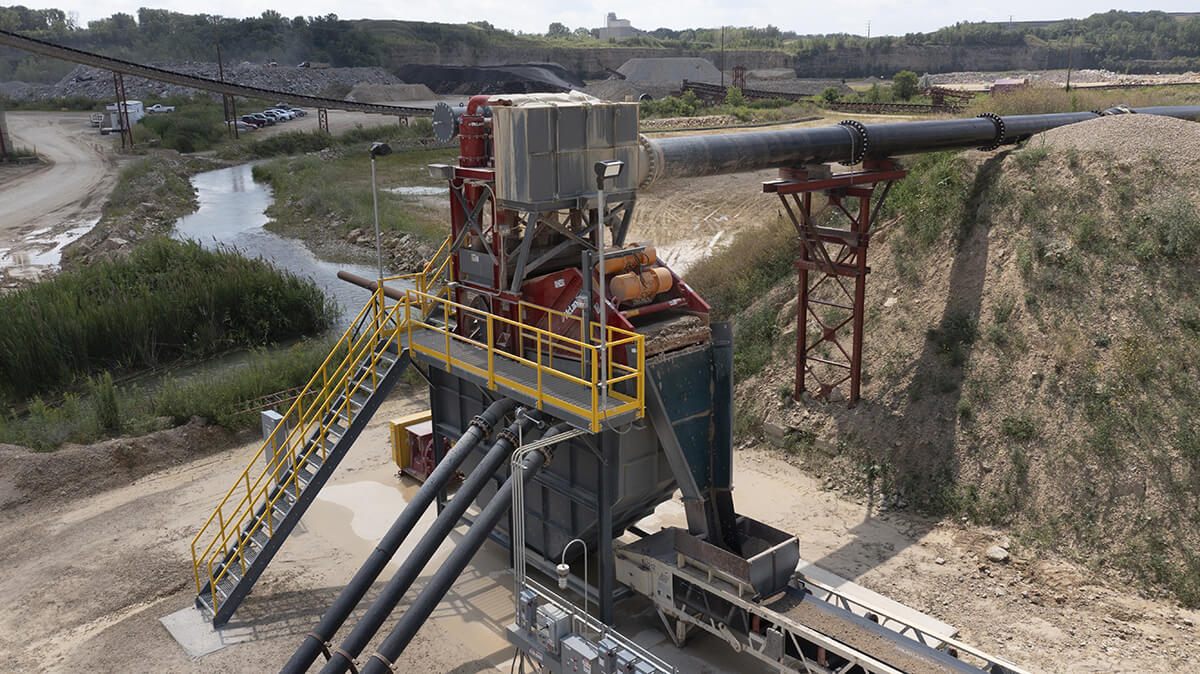Introduction
All aggregate wash plants generate a waste stream that consists of the process water, silts, clays and other fine materials that are removed during the washing process. Typically, this waste stream is sent a pond or some sort of impoundment where the solids settle out over time.
Settling ponds may seem like a cheap and easy way to deal with aggregate waste material (you just dig a hole, right?), but they can be a lot more costly and labor intensive than they appear. The solids have to be removed when the pond becomes full, which takes time, money and labor. You may have to rent an excavator to muck out the pond, and you have to dedicate personnel and other resources to the task.
But what if you could recover the fine solids from the waste stream before the settling pond? What if you could reduce the size of your pond and/or the frequency of which it needs to be cleaned? What if you could potentially put the fine solids back into your product pile or create an additional separate product?
With a Hydrocyclone, you can!
Hydrocyclones for fines recovery
Hydrocyclones and their variant the Separator™ are used for a variety of applications, including fines recovery. These simple machines have no moving parts and feature a feed box, feed inlet, vortex finder, conical sections and a spigot or apex.
Slurry is pumped to the Hydrocyclone, where it enters the feed box area through the feed inlet. Inside the Hydrocyclone, centrifugal forces pull the coarser particles toward the wall of the Hydrocyclone. The coarser particles travel downward through the conical sections and discharge out the apex.
Meanwhile, the finer particles and a majority of the liquid are pulled toward an air core in the middle of the Hydrocyclone to exit out of the top of the unit.
Separators™ feature the same components as a Hydrocyclone but include the addition of an overflow pipe, siphon control valve and underflow regulator fitted to the apex. The overflow pipe creates a siphon that closes the underflow regulator when the pipe is full.
Both Hydrocyclones and Separators™ are used for fines recovery but in different types of fines recovery applications. Hydrocyclones operate at higher pressures and make a finer cut, so they are typically used for ultra-fines recovery from effluent streams. Separators™ make a slightly coarser cut and are used for returning product-sized fractions back to the product.

Separators™ as part of a Scavenger System
Fines recovery can be as simple as recovering product-sized solids from a screw washer overflow. Recovering these fines reduces the volume of material reporting to the settling pond and allows them to be added back to the product pile for increased revenue.
When adding material back to the product pile, Separators™ are used as part of a Scavenger System. Scavenger systems can be configured in several different ways. They can consist of a Separator™ placed over the screw near the discharge end, or a Separator™ placed over a Dewatering Screen after the screw.
In either instance, the overflow from the screw washer is pumped up to the Separator™. The Separator™ recovers the product-sized solids and discharges them out the underflow and either onto the dry deck of the screw or onto the Dewatering Screen to be discharged with the product.
Separators™ are ideal for adding material back to the product pile because they provide an element of dewatering. The siphon valve and underflow regulator allow Separators™ to discharge a denser underflow than Hydrocyclones.

Hydrocyclones as part of an Ultra Fines Recovery System
Ultra Fines Recovery Systems remove fine solids from the waste stream ahead of the settling pond to reduce the volume of material reporting to the pond. Reducing the volume of material reporting to the settling pond has several benefits, including:
- Reduced pond maintenance
- Less pond cleanout
- A reduction in pond size
Plus, the recovered solids may be able to be sold as a secondary product for backfill or pond lining, truly generating profit from waste.
At the heart of a fines recovery system is the Hydrocyclone. Hydrocyclones can capture fine particle sizes down to 400 mesh, making them ideal for fines recovery applications.
Fines recovery systems can be configured with one or more Hydrocyclones, depending on the application. They are typically paired with a Sump, Pump and Dewatering Screen to provide a drip-free product that is easily conveyable and stackable.

Fines recovery with Hydrocyclones and Separators™ is the first step to better managing an aggregate waste stream. Additional steps involving other types of tailings management equipment, including Thickeners and Filter Presses, can be added to allow producers to eliminate their settling pond altogether. These steps generate immediately reusable process water and a drip-free, easy-to-handle solids product.








